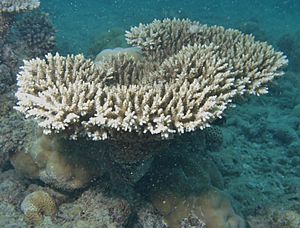Acropora microclados facts for kids
Quick facts for kids Acropora microclados |
|
|---|---|
 |
|
| Conservation status | |
| Scientific classification | |
| Synonyms | |
|
Acropora microclados is a type of coral that lives in the ocean. It belongs to a family of corals called acroporid corals. A scientist named Christian Gottfried Ehrenberg first described it in 1834.
This coral lives in warm, shallow parts of the ocean, usually on the upper slopes of coral reefs. You can find it at depths from 5 to 20 meters (about 16 to 65 feet). Sadly, Acropora microclados is a vulnerable species, which means its population is shrinking. It is not very common, but it can be found in many different places around the world.
What Does Acropora microclados Look Like?
Acropora microclados corals grow in groups called colonies. These colonies often look like a flat, bushy table or a cluster of branches. They can grow to be about 1 meter (3 feet) wide.
The coral has many small branches, called branchlets. These branchlets are short and become thinner at their ends. They are usually arranged in a neat pattern. The bottom part of these branchlets can be up to 10 millimeters (about 0.4 inches) wide.
This coral is usually a pale pink or brown color. During the day, its tiny tentacles stretch out and look grey. These tentacles help the coral catch food.
The branchlets have special cup-like structures called corallites. There are different kinds:
- Axial corallites are found at the very tips of the branchlets. They are shaped like tubes.
- Incipient axial corallites are new axial corallites that are just starting to grow.
- Radial corallites grow along the sides of the branchlets. They are also tube-shaped and are packed closely together. Each one has a small, nose-shaped opening.
Acropora microclados looks similar to other corals like Acropora lamarcki, Acropora macrostoma, and Acropora massawensis. This coral is made of a hard, stony material called aragonite, which is a form of calcium carbonate.
Where Does Acropora microclados Live?
You can find Acropora microclados in many parts of the Indo-Pacific Ocean. This includes the Red Sea, the Indian Ocean, the Gulf of Aden, the East China Sea, and the West Pacific. It also lives near places like the Cook Islands, Australia, Japan, Southeast Asia, Samoa, and Chagos. It is known to live in five different areas within Indonesia.
This coral prefers water temperatures between 25.48 and 27.23 degrees Celsius (about 77.8 to 81 degrees Fahrenheit).
Scientists believe the number of these corals is going down. They face several threats:
- Climate change and rising ocean temperatures can cause coral bleaching. This is when corals lose their color and become sick.
- Damage to reefs from storms or human activities.
- Coral diseases can spread and harm colonies.
- Predators like the Crown-of-thorns starfish (Acanthaster planci) eat coral.
- Human activities like pollution and overfishing can also hurt coral reefs.
Because of these threats, Acropora microclados is listed as a vulnerable species on the IUCN Red List. It is also protected under CITES Appendix II, which helps control trade of endangered species. This coral might also live in special areas called Marine Protected Areas, which are set aside to protect ocean life.
Who Discovered This Coral?
The first scientific description of Acropora microclados was made in 1834. It was described by a scientist named Christian Gottfried Ehrenberg. He originally named it Heteropora microclados.


